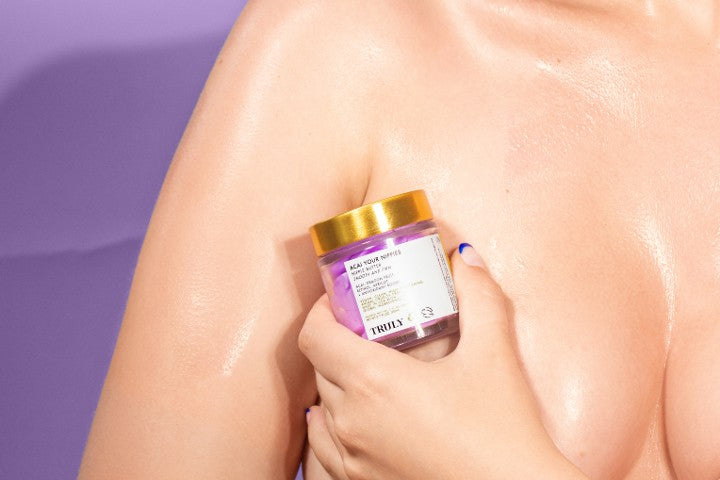
So you just took a shower and noticed some stray hairs sprouting around your nipples. That’s called nipple hair and yup, it’s a totally normal, totally common thing that affects a huge percentage of women. Just like your underarms, bikini area, and legs, nipples have hair follicles — hence the reason hairs grow there.
Usually, it’s caused by hormonal changes (menopause, breastfeeding, pregnancy) or hormonal imbalances (excess testosterone and androgens, too less estrogen) but in some cases it could be the result of a health condition such as polycystic ovarian syndrome (PCOS) or Cushing’s Syndrome. If you suspect you may have an underlying condition, seek professional help from a women’s health care provider.
As for how to get rid of nipple hair, that’s not too hard either. In fact, the hair removal process isn’t much different to any other part of your body. Here’s your guide to removing nipple hair easily and safely.
#1: Trim
If you’re seeing hair growth around your nipples, try snipping the hairs with a small pair of scissors at the base of the hair to remove them. It won’t remove the nipple hairs completely, as trimming doesn’t remove the root of the hair. However, if you’re looking for a quick fix that only takes a couple of minutes, trimming is your best bet.
#2: Pluck
Tweezing isn’t the most comfortable hair removal option, but it’s a fast way to remove nipple hair at the root. According to the experts, it’s better to extract nipple hair from the root rather than simply trimming or shaving, as this may only cause hair to become coarser.
Starting with a clean, dry pair of tweezers, hold the skin firmly with your free hand and tweeze with the other. It’s best to tweeze after a hot shower, as this will open up the hair follicles around your areola, making the process easier and less painful. Just keep in mind, tweezing can increase the chances of ingrown hairs. Once you’ve finished, follow up with a soothing nipple treatment like Truly’s Acai Your Nippies Butter.
#3: Wax
Waxing is a common method for removing all kinds of body hair, but it can also be beneficial in removing nipple hair. In fact, waxing (like plucking) is one of the best methods as it removes hair from the root. Another plus point is that waxing will eventually thin hair, so that it’s much finer and less visible when it grows back.
Since the nipple area is so sensitive, it’s better to get waxed by a professional aesthetician. Again, waxing can cause side effects like ingrown hairs and infection, so it’s always a good idea to leave it to the pros.
If you're waxing nipples at home, do not apply the wax to the nipple, but rather around it on to remove rogue strands. Finish with a soothing skincare product, like Truly’s Coco Cloud After Shave Serum.
#4: Shave
Shaving is a quick and painless way to treat hairy nipples. After taking a shower, grab a shaving cream and a clean, sharp razor. Hold the skin taut, and very carefully shave away those pesky nipple hairs. Take as much time as you need, and be careful not to cut your sensitive skin with the razor!
Our favorite products for getting the job done: Truly’s Coco Cloud Whipped Shave Butter + the Truly Blue Razor. To prevent ingrown hairs and irritation, dab on a little of Truly’s Cooka Concentrate.
#5: Try Electrolysis or Laser Hair Removal
As easy and convenient as shaving, waxing, plucking, and trimming are, if you’re looking for a more permanent solution, you should consider trying an FDA approved in office treatment like electrolysis or laser hair removal. Lasering is a dermatologist’s favorite choice.
"If it's dark, coarse hair, I would laser," says Mona Gohara, MD, a Connecticut-based dermatologist. "Since it's a small area, I'd suggest a more permanent mode of removal."
Laser therapy is also a great option if you’re dealing with excessive hair, as over time it thins out your body hair, making it appear less visible the more sessions you have. Once again, make sure you get it done by a licensed professional to get the best and safest treatment without any unpleasant side effects.
#6: Or Just Embrace ‘Em
There’s no rule that says women can’t have nipple hair. If it’s not bothering you, don’t feel pressured into removing it. In fact, feel free to embrace your hairy nips and give them some love with our Glazed Donut Oil.
WHEN TO SEE A DOCTOR
Nipple hair
According to New York gynecologist, Alyssa Dweck, MD, if you notice hair growth in unusual areas like your lips, chin, and chest, it could be a sign of hirsutism, which is a symptom commonly associated with polycystic ovarian syndrome (PCOS).
“Usually, hair wouldn’t just be isolated to the nipples if you’re having this issue with hormones,” explains Dr. Dweck. “If your testosterone levels are suddenly really high, you’ll see hair growth in unusual places, including the chest and nipples.”
If you experience a sudden appearance of hair on your nipples, upper lip, and chin, along with hair loss, irregular menstrual cycles, or infertility, this could signal a health concern such as PCOS or Cushing’s syndrome. Visit your doctor to help you determine the cause and get the appropriate treatment.
They may also suggest birth control if they suspect the underlying cause of hairiness is your hormones.
Having hairy nipples might be embarrassing for some people, but rest assured you’re not the only dealing with nipple hair. Plus, you have plenty of options if you want to get rid of your hair. Unless you’re experiencing other symptoms like those mentioned above, there’s really no reason to be concerned about having hair on your nipples. It’s way more common than you’d think, and nothing to feel ashamed about!






































